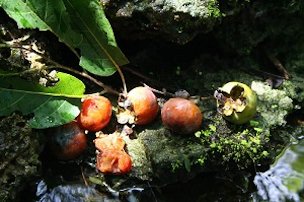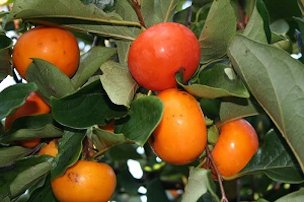From Fairchild
Tropical Botanic Garden
by Noris Ledesma, Curator of Tropical fruit
The American
Persimmon
As published in the Miami Herald
The American persimmon, Diospyros
virginiana,
is native from South Florida to New York and the central parts of Ohio,
Indiana, Illinois, and Missouri. In Florida, they grow wild in the
fields, pinelands and moist woods across our state. South of Lake
Okeechobee, it was the indigenous people who had the most success
making use of the American persimmon for food throughout the swampy
lowlands. Today, one can find remnant stands of American persimmon that
were planted hundreds of years ago, and they still produce fruit.
The
American persimmon has probably been the most neglected of our native
fruits and is now quite uncommon. The American persimmon growing along
the riverbanks and swamps across our continent are now a rare treat.
For years the fruit was considered a weed tree and was cut out to make
room for crops or to give more popular forest trees more room to grow.
There are some reports dating back to 1907 that describe varieties that
are still propagated today. Even then, some interested parties were
trying to create a market for the fruit that would justify the planting
of large orchards. Alas, they were not highly successful.

The
tree grows well in the South Florida landscape and excels with seasonal
inundation, unlike most of our home garden fruit. The tree is small,
less than 20 feet in height, and it sprouts profusely from the roots,
forming a persimmon coppice over time. It is a slow-growing tree. The
tree is admired for its picturesque form, zig-zag branching, beautiful
foliage and colorful fruit. The glossy, leathery leaves make the
persimmon tree a nice addition to the landscape. It is also one of the
only trees we have in South Florida that can provide Autumnal color to
our landscapes.
The wood is close grained, heavy, hard, and
strong. The American persimmon is perfect for cultivating bromeliads
and orchids, which root easily on the trunk and thrive with the ample
winter light within the bare canopy. Because of its hardness,
smoothness, and even texture, it was particularly desirable for wood
turning and even making golf club heads.
Male and female
flowers are usually borne on separate trees, but female flowers can
self pollinate. The flowers appear between March and June within its
botanical range and from March through May in areas where it grows
best. The flowers are pale cream and attract bees for pollination.

'Hudson' persimmon
The
fruit is green before ripening and may vary in color when ripe from
yellow, orange, dark reddish purple and sometimes even black. You can
tell they are ripe when they become soft to the touch. If eaten too
green they are highly astringent. They are enjoyed by people as well as
many species of wildlife for food. They taste similar to a dried date
or fig, and the large persimmon found in some fruit markets isn’t
nearly as rich and flavorful as our smaller native persimmon.
The
fruit can be picked when they are yellow and will finish ripening off
the tree, but the best way to enjoy them is by picking them ripe from
the tree. Fruits drop ripe from the tree from the end of September to
Spring. The pulp can be use in delicious cakes, cookies, puddings, jams
and pies. Dried fruit is added to baked goods and occasionally is
fermented with hops, cornmeal, or wheat bran into a beer-like beverage.
The dried, roasted, ground seeds have been used as a substitute for
coffee.
Persimmon is easily raised from seed. They should be
soaked 2 to 3 days before planting. Seeds lose their viability through
extremes of heat, cold or dryness. They should be planted in Spring in
shallow holes in light soils with plenty of humus and covered to a
depth of about one half inch.
The trees grow following the end
of the dry season and usually flush only once. Their growth is slow;
the home gardener has to have a degree of patience. The trees should be
heavily mulched and fertilizer should be applied once at the beginning
of the rainy season with a granular formulation of 8-3-9.
The
tree will remain green and bushy until the end of the summer and as we
enter the fall, the older leaves will turn light red and drop from the
tree. The fruit often hang on to the tree long after the leaves have
fallen. All leaves will drop during the winter and the tree will stand
bare until new leaves push out following the cool, dry season. Pruning
should be done during the winter to remove the height from the tree and
to form the canopy. Because there are no leaves, it is easy to
visualize your pruning work.
If you are looking for a green
(and temperate) alternative for your garden planting, the American
persimmon is a good choice. Its is a unique tree, capable of growing
across a large portion of the United States, and can adapt to many
different soil types and conditions.
Back to
American Persimmon Page
|
|

